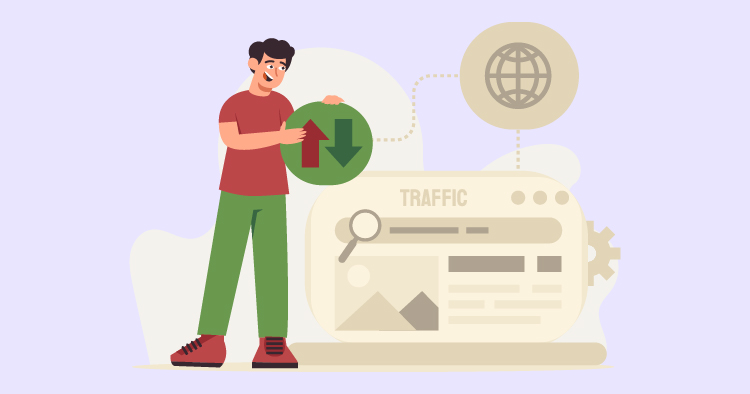If you’re running an online store, you know how important it is to stand out in search engine results. Good search engine optimization (SEO) can bring more people to your site and boost sales. But how do you get started? Here, we’ll share ten practical e-commerce SEO tips to help you get more organic traffic. These tips cover everything from improving your product descriptions to using backlinks to your advantage. With these ideas, your online store can shine brighter than the competition and attract eager customers.
Understanding SEO for Online Shopping Success
Knowing how to use SEO effectively is critical when running an online store. With more people turning to the internet to shop, your website must be easy to find and navigate. Let’s dive into some strategies that can help draw more customers to your online store, from selecting the right keywords to ensuring your site is free of technical issues.
Selecting the Right Keywords Through Research
Choosing the right keywords is essential for your online store’s visibility. Tools such as Google’s Keyword Planner can help you identify the terms and phrases shoppers are searching for. Use these insights to shape your website’s content and improve its chances of appearing in search results. Effective keyword research can significantly increase traffic to your site.
Think of keywords as a bridge that connects potential buyers to your products. Concentrate on long-tail keywords, more specific phrases that shoppers might use when they’re close to a buying decision. These can attract customers who are more likely to purchase. Integrate these keywords into your content naturally and enjoyably to read.
Remember, the popularity of keywords can shift with trends and seasons. Keeping up with these changes helps you stay competitive. Update your keyword strategy regularly to ensure you’re always targeting the most relevant terms. Investing time in ongoing keyword research is crucial for maintaining an effective SEO strategy.
Don’t overlook the importance of local SEO, either. Incorporating location-specific keywords can help you reach customers in your area. This is particularly useful for online stores that want to establish a local presence. By engaging with the community around you, you can increase visits to your site from local shoppers.
Maximize Your Online Store’s Potential with Structured Data
Adding structured data to your online store can work wonders for your SEO. It’s like a translator for search engines, helping them understand your content better. This clarity can lead to more detailed search results for users. Think of structured data as the secret sauce to boost your website’s visibility.
Structured data can also make your search results pop. It allows you to show off product ratings, prices, and availability in the search results. These rich snippets can make your links more tempting to click on. Choosing the correct structured data can make your listings more informative and attractive to shoppers.
Struggling with Digital marketing? Book Your Free Strategy Session!
- 30-Minutes Session
- Expert Insights
- Data-Driven approach
- Optimized Strategies for Your Goals
Select one of over 500 designs and establish your online presence.
- Free Web Hosting
- Fully Managed Solutions
- Scalable Websites
- No Hidden Cost
More and more people shop on their phones, so mobile optimization is critical. Structured data serves up info in bite-sized pieces perfect for small screens. This means a smoother experience for mobile shoppers, who can quickly find what they need. By using structured data, you’re making sure mobile users don’t pass you by.
Structured data isn’t just about looking good in search results now—it’s also about planning for the future. Tools like Google Search Console allow you to see how your structured data is doing. This information lets you tweak your SEO strategy for the best results. Think of structured data as a tool that helps you improve your online store.
Make Your Product Photos Great for Search Engines and Shoppers
Images are a magnet for shoppers’ eyes. They often look at pictures first, so it’s crucial to have high-quality images that present your products in the best light. You’ll want to balance the image file size and quality to ensure your website loads quickly while displaying your products attractively.
But there’s more to images than just looking good. It would be best if you also made them understandable to search engines. This is where ‘alt text’ comes into play. Alt text is a concise image description that helps search engines determine the content and context of pictures. Well-crafted alt text can contribute to better page rankings. Remember to make your descriptions precise and to the point.
Moreover, with the increase in mobile shopping, it’s essential to ensure that your images resize correctly on various devices. Responsive images enhance the shopping experience and positively influence how search engines evaluate your site.
Speed Up Your Website
A slow-loading website can be a deal-breaker. If your site takes too long to load, you might lose customers before they even see what you offer. To prevent this, streamline your website’s code, minimize redirects, and optimize image loading times.
Implementing browser caching can also improve speed. This technique allows a visitor’s browser to store specific files for quicker access on repeat visits. It’s a small change that can significantly enhance the user experience.
Finally, consider using a Content Delivery Network. CDNs distribute your site’s load across multiple servers, reducing bandwidth usage and accelerating visitor loading times. In the online shopping experience, every second saved can mean keeping a customer’s attention and potentially increasing sales.
Optimize Your Website for Mobile
Ensure your website is mobile-friendly, as most internet browsing happens on mobile devices. To ensure a good mobile experience, your website should adapt to various screen sizes, known as responsive design. This helps the site look great whether someone uses a desktop computer, a tablet, or a smartphone.
Select one of over 500 designs and establish your online presence.
- Free Web Hosting
- Fully Managed Solutions
- Scalable Websites
- No Hidden Cost
When working on a mobile version of your website, it’s essential to highlight the most important information first. Since mobile screens are smaller, you want to ensure that the content people need most is easy to find and read. Simplify your site’s navigation to help users find what they need without hassle.
Another critical point is to make sure your website is touch-friendly. Buttons and links should be big enough to tap with a finger without zooming in, and forms should be accessible to fill out on a mobile device. When your site is optimized for mobile, users will have a better experience, and search engines like Google will also look upon your site more favorably, which can help with your search rankings.
Optimize Your URL Structure
A clear and straightforward URL structure is surprisingly vital in search engine optimization (SEO). Start by organizing your URLs in a logical way that reflects the structure of your website. This makes it easier for search engines to crawl your site and for users to understand where they are on your site.
It’s also good practice to include relevant keywords in your URLs. This can make your website more visible in search results. Remember that cramming too many keywords into your URLs can do more harm than good, so keep it relevant and straightforward.
Finally, when you’re writing URLs, use hyphens to separate words. This makes the URLs more straightforward to read for both people and search engines. Think of your URL structure as the foundation of your website’s SEO; everything else can work more effectively when built well.
Avoid Broken Links
No one enjoys clicking on a link only to find it doesn’t work. It’s frustrating and can make your website seem poorly maintained, potentially causing customers to question your professionalism. To maintain your customers’ trust and satisfaction levels, it’s essential to check your website regularly for broken links. Fixing these links as soon as you find them helps provide a smooth and enjoyable browsing experience for everyone visiting your site.
Search engines aim to provide users with the best possible results, and broken links are a red flag that can negatively impact your website’s search engine rankings. Search engines see broken links as a sign of an outdated and possibly neglected site. You can use tools like Google Search Console (formerly Google Webmaster Tools) to find and fix broken links. By keeping your site free of broken links, you’re helping improve its visibility and making it easier for potential customers to see you through search engines.
When your site is free of broken links, visitors can move around it more freely and easily find the information they’re looking for, making it a more enjoyable and engaging experience. This ease of use encourages visitors to spend more time on your site, increasing their chances of being interested in your products or services. Ultimately, a well-maintained site without broken links can increase user engagement and, potentially, more sales for your business.
Struggling with Digital marketing? Book Your Free Strategy Session!
- 30-Minutes Session
- Expert Insights
- Data-Driven approach
- Optimized Strategies for Your Goals
Get Internal Linking Right
Internal linking is a crucial element of a well-structured website. It involves creating links that go from one page on a website to another page on the same website. The goal is to guide users and search engines through your site, connecting content and providing a clear path through your website’s pages.
Implementing intelligent internal linking strategies can significantly enhance users’ site navigation. When visitors find links that connect them to related content or products, they’re more likely to engage with your site further, which can lead to increased page views. More importantly, if these links are to products, this could also increase sales. It’s essential to ensure that the links you create are intuitive, making it easy for users to find the information they seek without getting lost or frustrated.
Internal linking isn’t just about user experience—it also plays a vital role in search engine optimization (SEO). By linking your pages to one another, you help search engines like Google understand the structure and hierarchy of your site. This clarity can improve how search engines index your pages, potentially boosting your visibility in search results. A well-linked site allows search engines to crawl your site more effectively, understanding which pages are most important and how they relate.
A thoughtful internal linking strategy can also contribute to a lower bounce rate. The bounce rate measures how often visitors leave your site after viewing only one page. By offering visitors links to content that piques their interest, you give them reasons to continue browsing your site. If users spend more time on your site because they’re clicking through to other relevant pages, it can indicate to search engines that your site provides valuable content. As a result, a lower bounce rate can indirectly signal the quality of your site, which can positively influence your SEO efforts.
Focus on Building Links
Building links is vital to improving your website’s online visibility. When you connect with reputable websites and influencers, they might link to your site. These backlinks are like votes of confidence that tell search engines your website is a reliable source. The more quality backlinks you have, the more search engines will see your site as valuable and trustworthy.
To build links effectively, you need to grow your network. This means connecting with industry leaders and joining community discussions. These relationships can lead to guest blogging, collaborations, and shared content, providing valuable backlinks to your site. A strong network can significantly boost your online presence.
High-quality backlinks can increase your website’s organic traffic. They serve as endorsements, making search engines view your content as relevant and valuable. As a result, your site is more likely to rank higher in search results, becoming more visible to people searching for information in your area. A higher search ranking often leads to more organic visits because users tend to click on the sites at the top.
Link building is more than just SEO; it can significantly improve your brand’s reputation. When respected websites link to your content, your brand is knowledgeable and trustworthy. This can make visitors more confident in your brand, which builds trust. As trust in your brand increases, so do customer loyalty and the chances of repeat visits and referrals. This kind of trust is precious as it can lead to long-term relationships with your audience and more people advocating for your brand.
Steer Clear of Duplicate Content
When creating content for your website, consider it your chance to show the world what makes your brand unique. Search engines, like Google, are always looking for fresh content that stands out and reflects your unique perspective and expertise. Maintaining originality in your content will appeal to search engines and delight your audience with something new and engaging.
It’s not just about staying in the good books of your audience; it’s also about maintaining a healthy relationship with search engines. Websites that host copied or duplicate content can face penalties, pushing them down in search rankings. To prevent this, it’s wise to regularly review your website’s content and ensure it’s unique, current, and relevant. This practice keeps your site in a solid position to be found and appreciated by users.
Imagine visiting a website and finding the same information you’ve seen elsewhere. It’s not a great feeling. When you’ve discovered something new and valuable—it’s a different experience. By avoiding duplicate content, you create a space where your audience can enjoy fresh insights and information. This builds trust and encourages visitors to return, knowing they’ll find valuable content unavailable elsewhere.
Final Thoughts
The digital shopping world keeps growing, making SEO more important than ever for bringing in visitors without paying for ads. Putting the ten tips we’ve discussed into practice will increase search engine rankings and make shopping more enjoyable for your customers. Remember that SEO isn’t something you do just once—it’s an ongoing effort. It’s crucial to keep up with changes in search engine algorithms and adjust your strategies accordingly. By doing so, you’ll be well-equipped to maintain your online store’s success over time.



